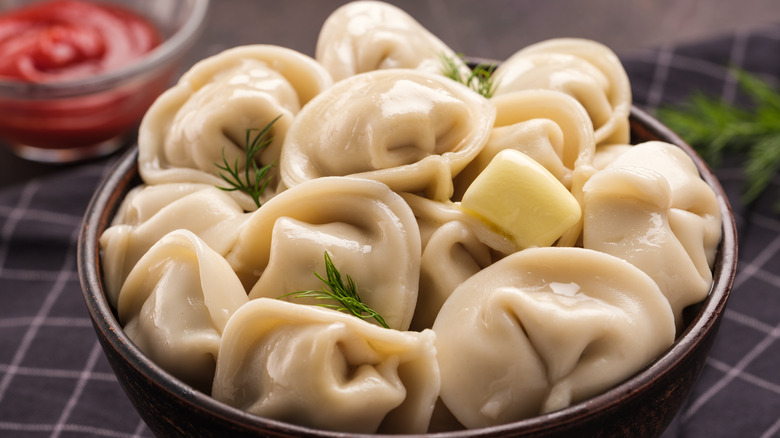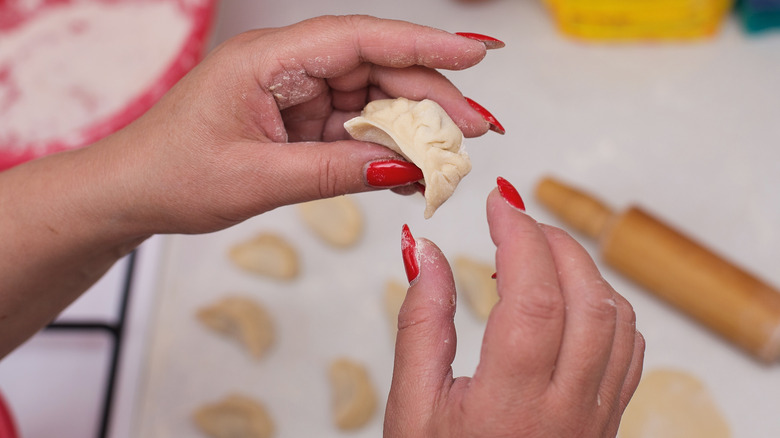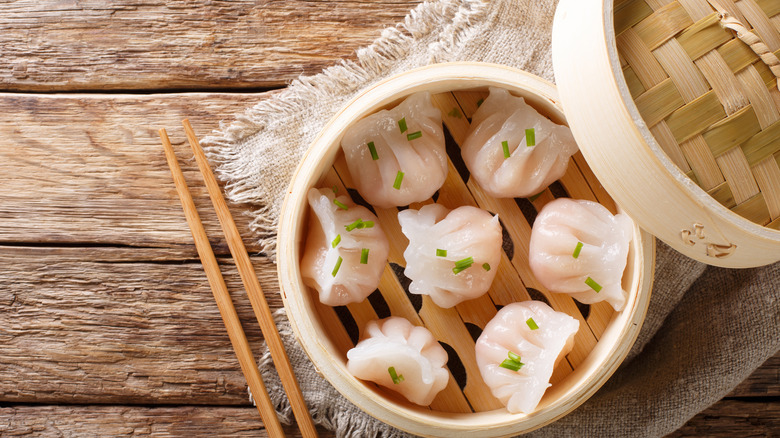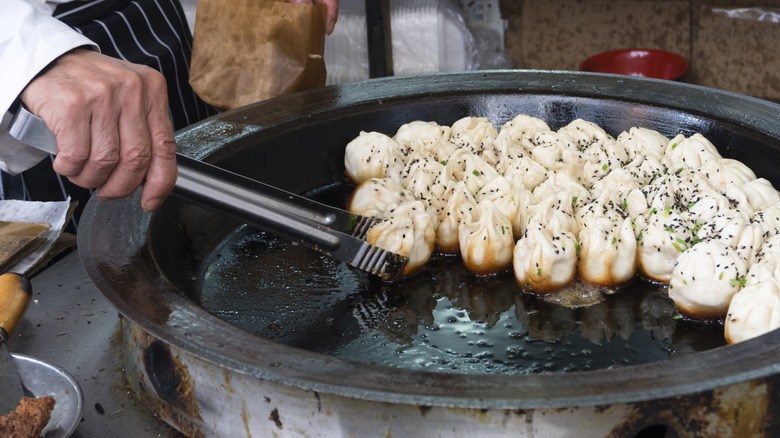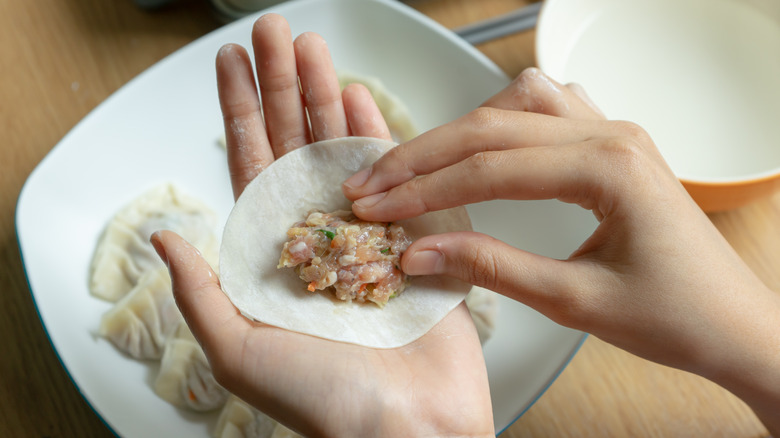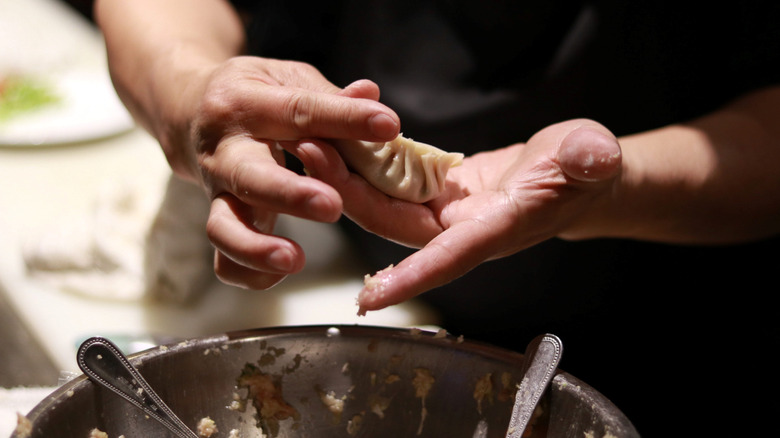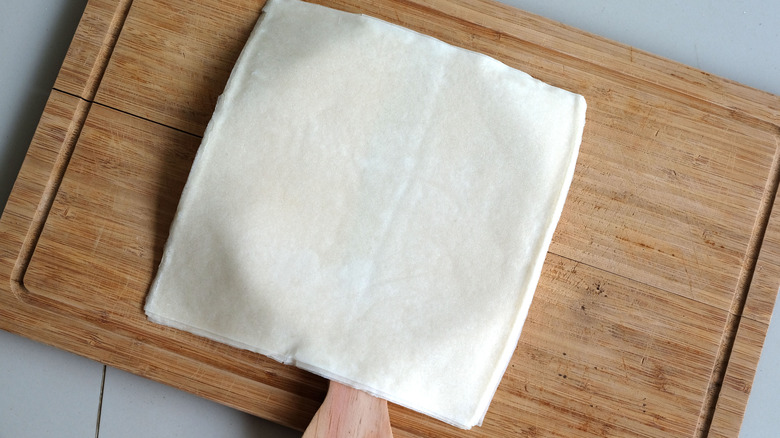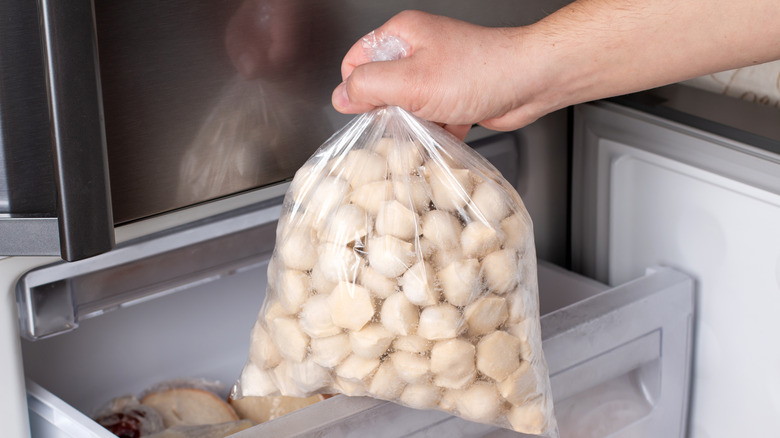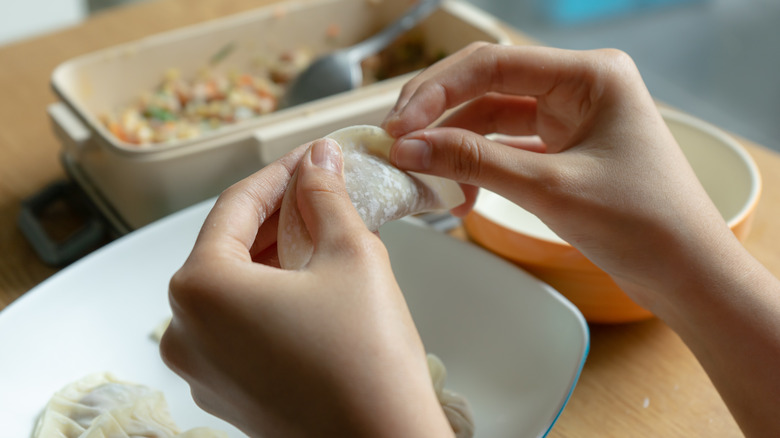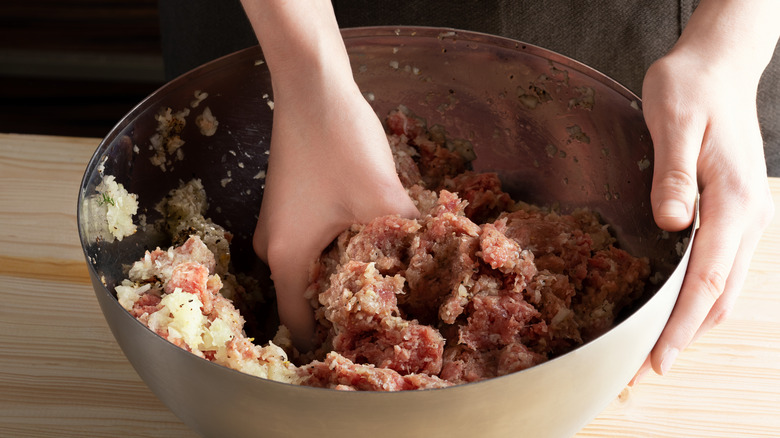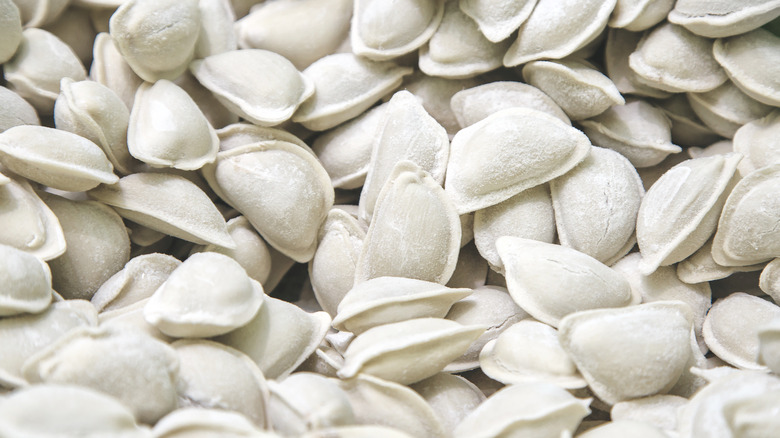10 Mistakes Everyone Makes When Cooking Dumplings
Dumplings are an Asian take-out food staple but also super easy to prepare yourself. The catch is, you do have a lot of choices in front of you when you decide it's time to consume some dumplings crafted in your own kitchen. Should you make them from scratch? If so, are you using store-bought wrappers, or mixing that dough up yourself? Should you go the easy route and just buy a bag of frozen dumplings? In that scenario, you've gotta then debate whether to steam, boil, or pan fry them, among other potential techniques.
When you do decide to cook the dumplings, whether you made them yourself or not, there are definitely a lot of do's and don'ts for yielding the best final product. Keep reading to learn about the most common mistakes associated with preparing dumplings, and how to avoid these no-gos the next time you've got a dumpling craving that must be satiated as soon as humanly possible.
1. Not pressing out all the air when you wrap the dumpling filling
Okay, let's assume you're taking the ambitious route and making the dumplings yourself. You've shunned the bags of pre-made dumplings, but you might still pick up some store-bought wrappers and just make the filling from scratch — either way, the method by which you wrap the filling is clutch if you want a well-sealed dumpling that survives the cooking process, especially if you're boiling them.
When you fold the filling into the dough wrapper, try to ensure that there isn't any excess air before you seal up the dumpling. Otherwise, there is a risk of the dumpling exploding while boiling. We know, it's sad to even think about such a senseless demise. In general, store-bought dumpling wrappers are a bit more durable and less likely to have this issue but it's best to still be extremely careful and press all possible air pockets out when you fold up the dumpling filling.
2. You're not using a bamboo steamer
Going the route of steaming usually results in that stretchy but still solid texture you might commonly associate with a dumpling. If your plan is to steam the dumplings (and if your plan is to be a regular consumer of steamed dumplings), buying a bamboo steamer insert that neatly fits into the pot or wok is highly recommended. Most dumpling cooking experts and enthusiasts agree that adding this item to your cooking arsenal is a must for dumpling perfection.
You'll also need to line the bamboo steamer to prevent the dumplings from sticking to it in the cooking process. You can utilize Napa cabbage leaves or parchment paper with strategic holes poked into it. While another type of steamer insert could work for boiling dumplings, the bamboo ones are inexpensive and spacious so definitely worth the splurge, if you want to perfect the process of steaming these babies.
3. The pan isn't hot enough when you fry the dumplings
While pan-frying is certainly one of the quickest ways to cook dumplings, it still requires a little bit of patience (hey, if you wanted instant dumplings, you could have gotten take-out or delivery). The issue that usually arises with pan-frying is the dumplings sticking to the pan. In order to avoid this, you have to let the pan get sufficiently hot before dropping those little meat/veggie sacks into the oil. Dumpling pros recommend the "water droplet test." When the water hits the pan and small balls form and roll around, the pan is the perfect temperature for dumpling cooking. It's worth noting, if the water sizzles and quickly evaporates, the pan is likely too hot, and if the water sits there and starts to bubble, the pan is, in turn, not hot enough for the dumplings to properly do their thing.
Take the effort to heat the pan with this in mind, and your dumplings should pan-fry beautifully.
4. You're adding water when sealing homemade dumpling wrappers
As previously mentioned, when making dumplings at home, you have the option to either use store-bought dough wrappers to cover your filling, or to make the wrappers from scratch (usually with very few ingredients beyond water and flour). If you go with the latter, there is a key detail to keep in mind — the amount of moisture already present in the wrapper. If you make the wrappers yourself, there is inherently already enough moisture there, so you don't have to add any additional water when sealing the wrapper around the filling.
This is contrary to the wrapping method recommended for store-bought ones, which need some additional moisture dabbed on the ends in order for them to seal up the filling effectively. So in summary, do not add water to the edges of your made-from-scratch dumpling wrappers, unless there is an excessive amount of dusted flour present that might have upped the dryness of the wrapper.
5. You're cooking the meat of the filling before wrapping it
This is one of those questions a novice dumpling chef has probably Googled, and we know this because there is an entire Reddit thread dedicated to the question. When you're whipping up the filling for a dumplings and you're using meat, should you cook the meat prior to preparing then steaming/frying/boiling the dumplings? The short answer is no.
Per multiple participants in the Reddit convo, the meat in the dumpling should always be "raw" prior to cooking and one person explained, "the amount of meat in there is so small that a light steam or pan fry will cook them perfectly." Another Redditor relayed, "... usually if it's raw I find that it becomes compact like a little meatball. If it's cooked/browned, it tends to be a little more crumbly."
It's definitely a valid question but the consensus seems to be that if you're making dumplings from scratch and planning to use a meat for the filling, it's not necessary to cook the meat before mixing it with various other ingredients to create the inside layer of the dumpling.
6. You're not curating homemade wrappers to the dumpling cooking method
Here's another useful tip if you're planning to make the dumpling wrappers yourself: Think about the cooking method you plan to use as you prepare your dough. The water temperature can affect how thick or thin the dough is, and certain cooking methods can withstand thinner dumpling dough better than others. For example, if you intend to boil dumplings sealed with homemade wrappers, you should use cold-water mixed dough since it's thicker.
On the other end of the spectrum, pan-fried dumplings or even steamed dumplings are easier on the dough, and can therefore handle dough that was formed with hot water, which tends to be on the thinner side. Per the cooking experts at Chowhound, aiming for "medium thickness," which is about ⅛ inches thick in the center and ⅙ inches thick at edges, is your best bet. Apparently, hot water is the go-to temp for achieving these dimensions in a homemade wrapper.
7. You're thawing frozen dumplings before cooking them
To thaw or not to thaw? The answer with dumplings is pretty straightforward. While this may seem counterintuitive, there is no need to thaw out frozen dumplings prior to cooking them, but there is a little bit of wiggle room on this suggestion, depending on how you cook them.
When you're steam-frying them, you can take the dumplings directly from the freezer to the pan. When you're boiling them, you can allow them to sit for 10 minutes or so outside of the freezer before cooking. The only caveat is, you don't want to let them fully thaw or the result can be a "mushy" dumpling. So again, keep in mind the cooking method when deciding how long to thaw, but know that, as a general rule, it won't take an ungodly amount of time to cook the dumplings if you're starting with ones that are straight out of the freezer.
8. Not pinching firmly enough when you seal the dumpling wrapper
When you're wrapping your own homemade filling for dumplings you've opted to lovingly make from scratch, sealing the meat or vegetable mixture within the dough can be the trickiest part. This is especially true if you're working with store-bought wrappers, which tend to be drier than the homemade kind. Nobody is born with perfect dumpling wrapping abilities. Those skills gotta be honed with time and patience, and maybe some less than picture-perfect dumplings.
Something to keep in mind (besides the fact that an aesthetically imperfect dumpling can still taste very good), because of the tendency for the wrappers' edges to resist effortlessly fusing together, it's best to press the edges really hard between your thumb and index finger when squeezing them together, after dabbing the edges with water via a pastry brush if necessary, when you seal the wrapper. A little practice and you'll be an expert and sealing up those dumplings.
9. You're not utilizing leftover filling for other non-dumpling dishes
Of course, dumplings are just the beginning. Some would argue that the best part isn't the stretchy dough that holds the minced meat and/or veggies but rather the actual minced meat/veggies — the filling you prepare to stuff inside the dumpling wrapper, which has so much culinary potential. So if you find yourself with the leftover filling because you've got more filling than you've got wrapper, or if you want dumplings but realize midway through the cooking process that you don't have the mental capacity to deal with dough, there are some fun options for how to utilize the inside stuff.
Epicurious shared a lot of possibilities and suggestions, from using the filling to shape burger patties, to making a soup version by forming meatballs with the filling and combing them with broth and your favorite leafy green. You can put the meat filling over a salad (cooked, of course) for some protein too. All we're saying is, limiting yourself to just dumplings when you're mainly craving the taste of what's inside the dumpling isn't necessary.
10. You're not getting creative enough with frozen, store-bought dumplings
Frozen dumplings are no doubt an easy, quick way to get some good grub down your gullet pretty quickly. Take them out of the freezer, heat a pan with some oil and you're well on your way. And they can certainly be very satiating on their own. However, if you start to think of dumplings more like the base of a good lunch or dinner (or breakfast, who are we to chain ourselves to typical meal norms?), you can really get creative and treat them more like a full meal, rather than a hearty appetizer.
Among a host of dumpling hacks, Eater suggests viewing the dumplings as a base for the meal, then the sky is the limit. Try them over rice, or mixed with more Italian-food-associated accompaniments like tomatoes, cheese, and/or Alfredo sauce. You can also serve them over a bed of rice or as a quesadilla. Again, there's more to dumplings than just, well, dumplings. Be sure you help them reach their full potential.
